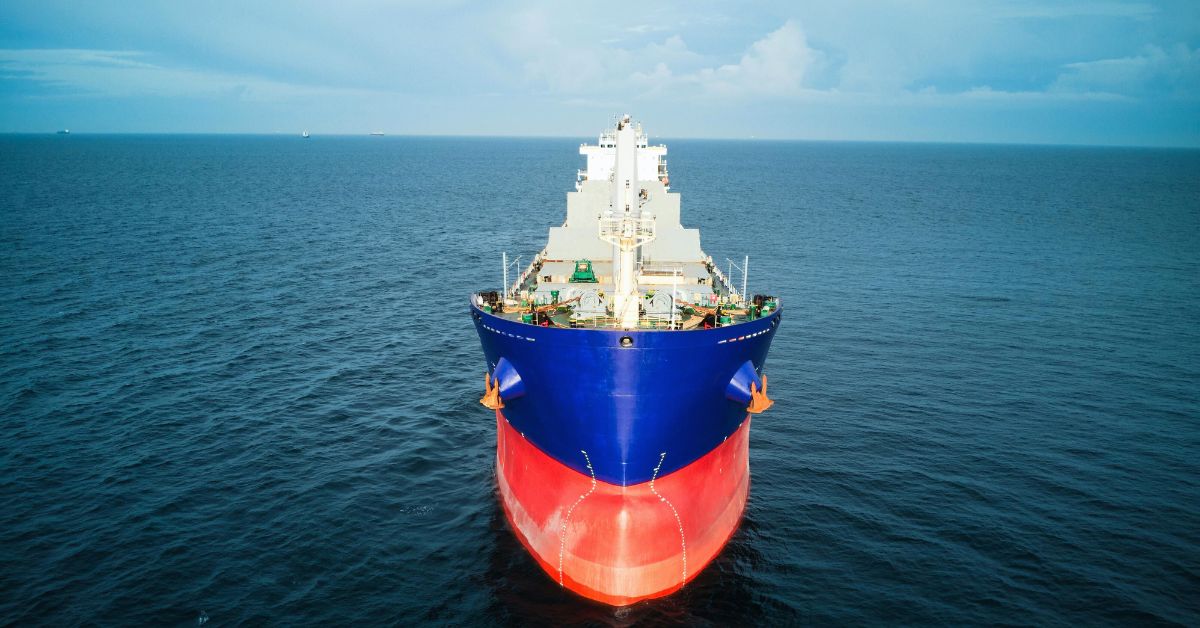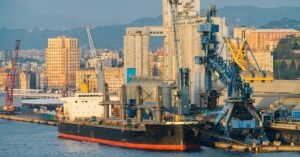The Dry Bulk Shipping Sector is the biggest segment of the maritime industry. It drives economic activities and supports urbanisation, manufacturing and infrastructural growth around the world through the transport of unpackaged, solid raw materials in massive quantities. Without the dry bulk segment, the modern world as we know it, from the steel and cement in our buildings to the grain we consume, would not exist on the present scale.

Dry Bulk commodities can be categorised into two groups: Major Bulks and Minor Bulks. The former are high-volume cargoes including iron ore, grain and coal. The latter includes a wide range of materials such as fertilisers, cement, sugar, salt, steel, bauxite and agricultural products like soybeans.
The Dry Bulk Shipping Market was valued at $162.6 billion in 2023 and was estimated to grow with a CAGR of more than 4% between 2024 and 2032.
The global trade of dry bulk commodities was over 5.6 billion metric tons in 2024, and China imported more than 41% of all dry bulk cargoes.
Iron ore was the most shipped commodity, accounting for 1.68 billion tons of the total, with Australia being the biggest exporter.
What Is Dry Bulk Shipping?
The Dry Bulk Sector involves the transportation of loose, homogenous goods which are not packaged or kept in containers, rather loaded directly into the ship’s cargo holds.
Different Types of Bulk Carriers
The ships used for this purpose are called bulk carriers or dry bulkers and vary in size.
Handysize/Handymax/Supramax: These vessels are the smallest and most versatile, ranging from 10,000 to 60,000 DWT. They can access most ports, given their size. Many of these are geared, meaning they have their cranes to load and unload cargo. They usually transport cement, sugar, fertilisers and agricultural goods.
Panamax Ships: These vessels are named so because of their ability to pass through the original locks of the Panama Canal. They have a capacity ranging from 60,000 to 80,000 DWT. They are important for shipping major bulk cargoes such as grain and thermal coal over vast distances, especially between the Atlantic and Pacific Oceans. The expansion of the Panama Canal created a ‘Neo-Panamax’ class of vessels. Also called the New Panamax, these ships can transit the expanded locks of the Panama Canal.
Capesize: These ships have a capacity of more than 100,000 DWT. These are too large to pass through the original Panama Canal and had to go around the Cape of Good Hope or Cape Horn, hence their name. They are used for long-haul transport of the two most dominant dry bulk commodities, which are coal and iron ore. Their humongous size makes them the most cost-effective solution for these high-volume trades.

VLOC/ULOC (Very Large Ore Carrier/Ultra Large Ore Carrier): This is a specialised subset of the Capesize class and exceeds 200,000 DWT. These ships are constructed to transport dense iron ore.
The Biggest Bulk Carrier: The Valemax Class
Valemax class, commissioned by Brazilian mining company Vale S.A., are the largest bulk carriers in the world. They were built to transport iron ore from Brazil to European and Asian ports, especially China.
The first ship of the Valemax class was Vale Brasil or Ore Brasil, which entered service in 2011 and remained the longest ship in service for a short period.
Other examples include the Berge Everest and the Pacific Flourish.
Valemax ships are 360 to 362 m long, with a beam of 65 metres. They have a deadweight tonnage of 380,000 to 400,000 DWT. To put it into perspective, a Valemax can accommodate sufficient iron ore to produce the steel needed to build 3 Golden Gate Bridges.
Valemax ships have a draft of 23 m when fully loaded, hence they can access only a few ports, such as Brazil’s Terminal Maritimo de Ponta de Madeira and terminals in China and Rotterdam.
Major Dry Bulk Shipping Companies
The Dry Bulk Sector is fragmented with hundreds of shipowners and operators, though a few players stand out due to their fleet size and reach. Many of the biggest shipping companies, such as Maersk and MSC, mainly focus on the container segment and have minimal or no dry bulk fleets.
The following companies are prominent names in the Dry Bulk Sector.
1. Oldendorff Carriers
This German Company, with 18 offices worldwide, operates a fleet of around 700 vessels at a given time, which includes both owned ships and chartered-in vessels. This enables them to maintain flexibility in operations and adapt to changes in market conditions. As of April 2025, the company’s fleet included 697 ships with a total capacity of 65 million DWT.
The company’s business model is based on diversity, and their ships carry all kinds of dry bulk. However, they are quite active in transhipment, where cargo is transferred from a large mother ship to a smaller daughter ship to reach ports having limited infrastructural facilities.
Their Capesize ships carry iron ore from Brazil and Australia to China and other Asian markets. Their Supramax and Handysize ships service smaller regional routes which are not accessible to larger ships, connecting ports in atleast 60 countries.
2. Star Bulk Carriers Corp.
Known as one of the largest publicly traded dry bulk companies, Star Bulk Carriers operates a fleet of 142 owned ships with a 14 million DWT capacity.
Their ships usually transport major bulk, including iron ore and coal from Australia to China, Brazil to China and also long haul coal routes from Indonesia and Australia to Asian countries.
In 2024, the company’s fleet transported more than 80 million metric tons of cargo.
3. Pacific Basin Shipping
This company specialises in smaller segments and possesses one of the world’s largest fleets of Supramax and Handysize ships, with approximately 277 ships under its control, including the ones it owns and charters.
Their ships transport cement, fertilisers, steel products and agricultural goods like logs and grains. The company’s geared vessels can access ports with no shoreside cranes, enabling them to serve many customers and routes that are inaccessible to large, gearless ships.

4. Golden Ocean Group Limited
This company operates approximately 90 ships with a capacity of 13.7 million DWT. Their fleet includes Newcastlemax ships, Kamsarmax, Panamax and Capesize vessels.
Given the company’s focus on major bulk cargo, its routes are concentrated on the main arteries of dry bulk trade.
5. Navios Maritime Partners L.P.
Navios Maritime Partners operates a diversified fleet of 174 ships as of early 2025, with a total carrying capacity of 15.5 million DWT. It has 69 bulk carriers, tankers and container ships.
They operate Capesize, Kamsarmax and Handymax ships. This allows them to transport a wide range of dry bulk cargoes, including iron ore, coal, grain and other commodities.
Their bigger vessels are used for main commodity trades, while the Handymax fleet offers a more flexible service for regional and minor bulk trades.
Navios is a major logistics company with business in the Hidrovia region of South America, involving the transport of agricultural and mining products via river barges.
Why is Dry Bulk the largest Shipping Sector?
The dominance of the dry bulk segment is tied to consumption patterns and economic developments. As economies industrialise, the demand for raw materials like steel and coal rises.
Additionally, an increasing global population raises the demand for agricultural products. The dry bulk sector is the most cost-effective way to meet this demand over long distances.
The dry bulk market operates on a tramp shipping model, meaning that ships do not follow fixed schedules or routes. On the other hand, they are chartered to transport cargo between any two ports as needed, offering immense flexibility.
Challenges Faced By the Dry Bulk Sector
1. Volatile Freight Rates
Freight rates are volatile and are determined by the interplay of global demand for commodities and the supply of available vessels. This is best reflected in the Baltic Dry Index, a major benchmark which tracks the cost of shipping major raw materials.
In 2019, Capesize vessel rates hit a 4-year high of around $34,000 per day. In 2020, due to the economic slowdown from the COVID-19 pandemic, these rates plummeted to as low as $2,500 per day, a drop of over 92%.
2. Environmental Regulations and Decarbonization
The maritime sector faces immense pressure to reduce its carbon footprint. The dry-bulk sector, with its ships burning heavy fuel oil, contributes to greenhouse gas emissions.

To deal with this, the IMO has implemented regulations like IMO 2020 that limit sulphur content in marine fuel and has set a target of achieving net-zero GHG emissions by around 2050, with targets of achieving a 20% reduction by 2030 and a 70% reduction by 2040.
Shipowners must adopt measures such as the Energy Efficiency Existing Ship Index (EEXI) and the Carbon Intensity Indicator (CII).
The CII was implemented in 2023 and gives a rating to ships based on their carbon emissions per nautical mile. A ship receiving a poor rating has to submit a plan to improve its performance, which can be costly.
3. Transition to Alternative Fuels
Another challenge is the adoption of cleaner fuels such as LNG, methanol, ammonia and hydrogen. This is due to high costs, limited bunkering infrastructure and technical challenges with onboard storage and engine technology.
A newbuild vessel which complies with future emission regulations can cost tens of millions of dollars more than a conventional vessel.
4. Geopolitical Tensions and Supply Chain Disruptions
Conflicts, wars, and tensions can disrupt maritime trade and increase operational costs. For instance, the Russia-Ukraine conflict significantly impacted coal and grain trades, forcing cargo owners to find alternative suppliers and routes.
Houthi attacks on commercial ships in the Gulf of Aden and the Red Sea have forced many vessels, including dry bulk carriers, to re-route around the Cape of Good Hope.
This longer route adds time and costs, increasing fuel consumption and insurance premiums. For a typical Capesize ship, the detour can add 10 to 14 days to a journey and increase fuel costs by more than $ 1 million per trip.
Trade wars, such as tariffs imposed by the U.S and China on many goods, can affect trade flows and reduce overall demand for shipping.
5. Digital Transformation
The maritime industry recognises the importance of digitalisation for efficiency; however, the dry bulk sector has been slow to adopt new technologies compared to the container shipping segment.
This is due to the traditional and fragmented nature of the market, with several smaller players lacking capital or expertise for a full-scale digital transformation.
However, real-time ship tracking, data analytics for voyage optimisation and predictive maintenance can lead to significant cost savings.
For example, route planning using real-time weather information can save fuel consumption by 10 to 15%. A 2024 report by the World Bank revealed that despite the mandate for electronic data exchange, only a third of more than 100 ports surveyed were in full compliance, revealing a major gap in digital infrastructure.
Lastly, the maritime industry is becoming prone to cyber attacks that can disrupt operations, compromise sensitive data and pose a threat to safety and security.
Conclusion
The dry bulk sector is a vital part of the maritime domain. In 2024, the active dry bulk fleet rose by 3.1 per cent to just around 17,500 ships. Over a billion tonnes of coal were shipped in 2024, with Indonesia and Australia being the largest exporters. Trade volume of soybeans also hit a record high of just under 152 million tonnes in 2024, with Brazil leading the exports.
You might also like to read-
- Largest Bulk Carrier In The World
- 12 Biggest Bulk Shipping Companies
- What are Bulk Carrier Ships?
- Top 5 Biggest Bulk Carriers In the World

